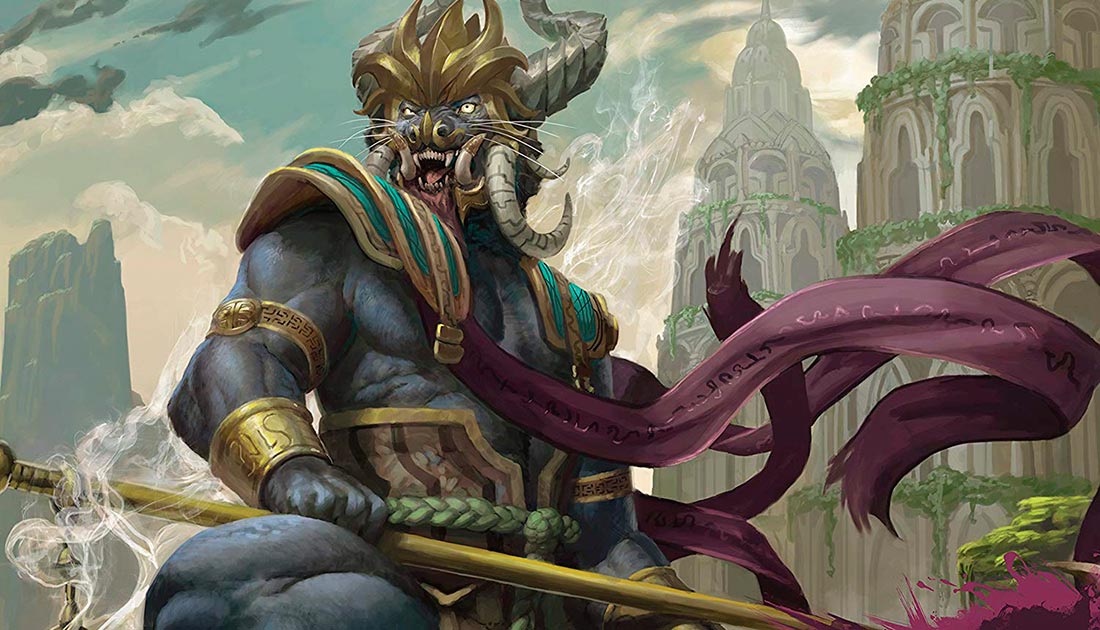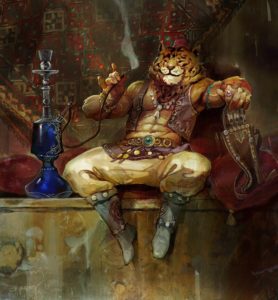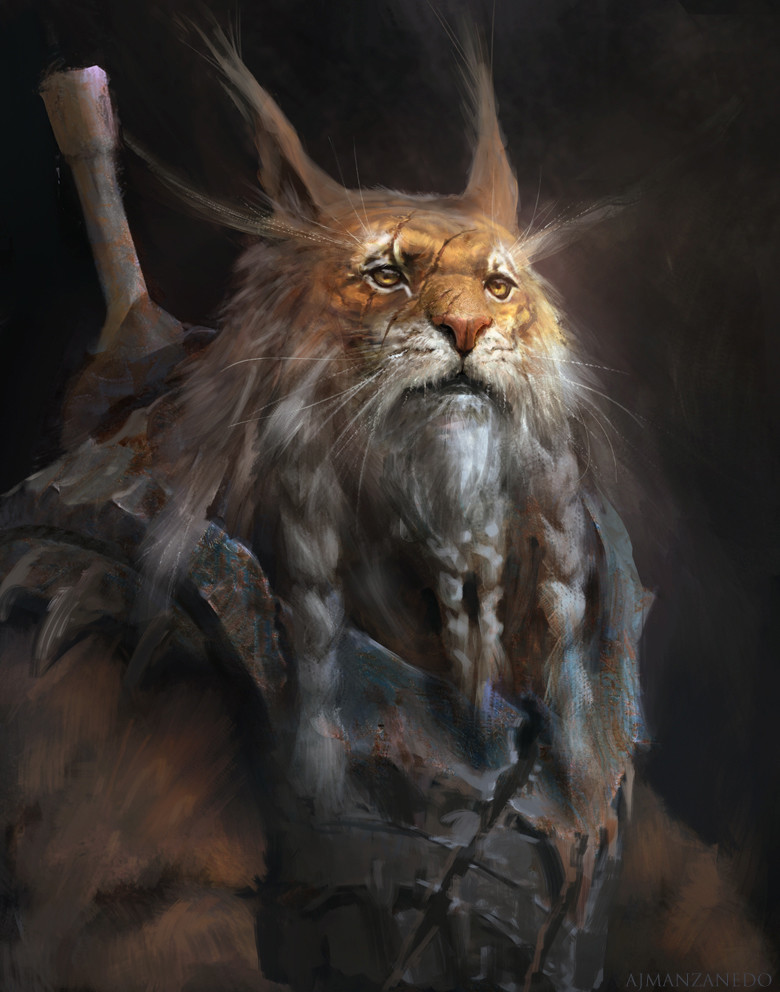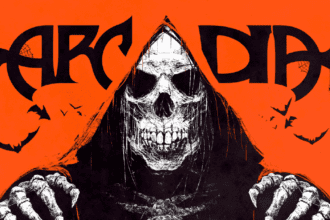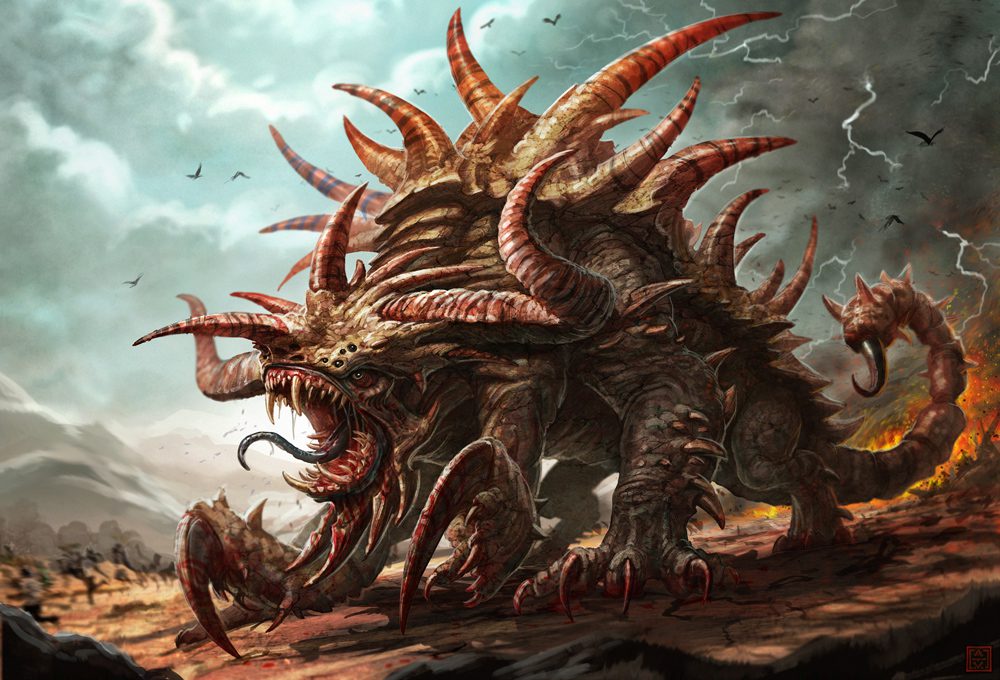Rakshasa: Advice on how to run one
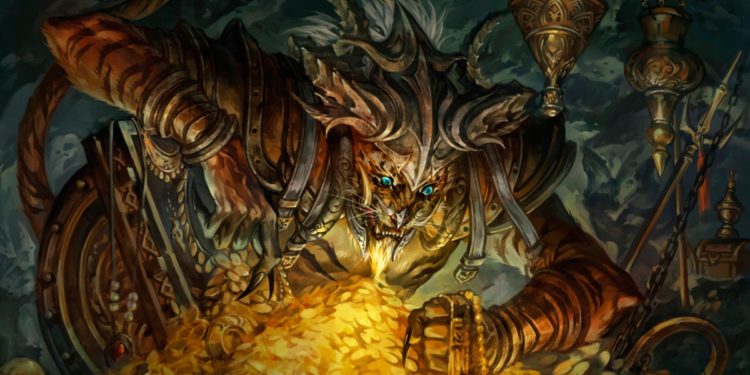
Thumbnail art by MtG artist Erica Yang
It’s time for a different monster to be used in combat. It’s the rakshasa‘s turn to shine! With the recent release of Baldur’s Gate: Descent into Avernus I think it’s about time I feature a devil for these kinds of articles. You will notice, however, that I changed the title up a bit from the more recent Mummy Lord’s Lair, and Aboleth’s Lair articles, in which I also explained how to properly use those monsters: There is no lair I’m going to be talking about, or at least it’s not entirely necessary for this creature. Why is that? That’s because if you manage to successfully use this creature, it may never need to enter combat against the player characters.
Rakshasas, as told by mythology
Rakshasas come from Indian mythology, depicted as musculus humans with the face of an animal (these normally being feline). Their claws are sharp and venomous, as well as their tusks. Rakshasas’ palms are where the backs of the hands would be on a human. Even though they are formidable warriors, it’s their words and deceptive nature that scares people the most. Gaining a rakshasas’ hatred means both you and your loved ones will eternally suffer. Sorcery does not affect these creatures and are immortal in nature, meaning that even after death they come back with all their memories. It is said that their evil nature comes from all terrible things they keep accumulating from previous lives.
Besides being some interesting bit of knowledge, I decided to add this to the article to give you flexibility when creating your rakshasa. You don’t need it to have a tiger’s head (even though it looks pretty cool). You can have it be a lion or panther’s head, even a bull’s or monkey’s one. Rakshasas have both their teeth and claws imbued in poison, however, only claws appear in the monster’s stat block and their well-known poison was traded with a curse. The curse may be extremely cool, but it won’t do much in combat. Feel free to add in the following things for the rakshasa to be even more menacing (if you are looking to have it be a boss monster for example):
- Add 13 (3d8) poison damage to the claw attack when it hits
- New action:
- Bite: Melee Weapon Attack: +7 to hit, reach 5 ft., one target. Hit: 7 (1d10 + 2) piercing damage, and the target must make a DC 18 Constitution saving throw, or be poisoned for an hour. [This Save DC was determined by the creature’s CR. You may reduce it if you like so as to have it not be that nasty. A DC16 is still dangerous enough, but not super deadly.
The ultimate plotter
If possible, rakshasas won’t ever put themselves at risk. Their innate spellcasting abilities allow them to do so. They are masters of manipulation, charming and escape. No rakshasa works alone, but with a group of charmed, or blackmailed individuals to protect him. It will do everything it can so nobody can tie the mishappenings in town to it. Meanwhile, the rakshasa will maintain a humanoid form as a disguise by using the disguise self spell. Only by being able to follow all the threads back to it will you ever find out that the town’s governor was, in fact, a rakshasa all along.
But how is it one can create an epic detective story in which the players little by little find clues that lead them to the rakshasa by the end? There are lots of different ways to do this. You don’t need to be a super genius to create a believable and fun plot of this kind. The internet has already lots of tips and videos to give that I will not focus on in this article. I may create some article in the future on how to create a good mystery in D&D, but in the meantime, I extremely recommend the City of Mist’s RPG section on how to create great mysteries for TTRPGs. You may have to pay for it, but it’s a great game nonetheless. The trick lies in having several mini-adventures throughout the story that reveal a little about the true villain (the rakshasa in disguise). By the time the players find out, it’s time for the monster to intervene:
Framing other people
The rakshasa may leave no trace behind when it acts, but it may leave evidence tying some crime to another person it may want to be removed from the scene. Maybe the rakshasa is the guise of a noble and wants to have the player characters get rid of all its business’ competitors. The best part is it doesn’t even need to do the things itself. The rakshasa can always command some random (or specific) person to do its evil schemes.
Want the rakshasa to be even more intelligent and nefarious? Have it charm someone to forge a document framing the city mayor for a crime, and plant the evidence in some other charmed criminal. If the party starts opposing the mayor after dealing with this criminal, have the rakshasa blackmail him/her. The PCs are its tools, and they are easily manipulable. In no time, the mayor will end up a puppet.
Framing the player characters
Did the players start connecting the dots and finding out something is not right? Time to put the whole continent against them! If the rakshasa is already in a good position of power, have it dominate some group of town heroes, prophets, maybe even the king to have the PCs hunted and arrested for committing some serious crime. The rakshasa will make others do the work while it continues in the shadows. The fewer people know about him and the person he is disguised as, the better.
Making the best use of its stat block
Vulnerability: Out of all the resistances, immunities and more, the only surprising thing is this monster has a vulnerability. Why rakshasas are vulnerable to piercing damage from magic weapons wielded by good creatures I have no idea. I found no lore nor mythological explanation saying why this is the way it is. However, I do like rakshasas having this vulnerability. It gives them quite a lot of flavor. Just like vampires can’t near garlic, rakshasas fear pointy weapons wielded by good-aligned creatures. This speaks of the cowering nature of rakshasas. It can also be used for some neutral character to realize they are in fact good in heart after dealing heavy damage to the rakshasa with a piercing weapon.
Limited Magic Immunity: This may be one of the most important parts, if not the most vital part of the monster. This is the reason the rakshasa will last a bit longer in combat, what makes it undetectable, and a monster to be feared upon. No spellcasters below lvl 13 will be able to do much to it, and even if they were of that lvl or higher, they won’t have many spell slots to use against the rakshasa. Nevertheless, the best way to make use of this trait is by making sure the rakshasa remains undiscovered once invisible (true sight, detect magic and other similar spells don’t work as they are below lvl7). Takin into account spells like Counterspell wouldn’t affect it unless they are cast on a high enough lvl.
Spells:
-
- Detect Thoughts: Perfect for manipulation or knowing the PC’s real intentions. If you want some badass moment, have the rakshasa read some player character’s mind right before dying so it can haunt the PCs family members in the future upon its resurrection.
- Disguise self: The rakshasa will want to be disguised at most times. There are only two moments in which it won’t: Whenever it wants to intimidate someone, or for battle, as there is no reason to hide its true nature during combat.
- Mage hand:I couldn’t find any specific way in which mage hand could be useful. It’s highly situational, so just use it when you see fit. Casting it while invisible would break the spell, so you can’t use it that way. You could add in the ‘Mage Hand Legerdemain’ ability from the Arcane Trickster if you like to make the rakshasa more interesting.
- Minor Illusion: I would use this spell to trick other people to think the rakshasa has something that belongs to whoever they are talking to. This puts the rakshasa in a position of power over the other. As an example, the rakshasa could make some contract some noble signed appear that talks about how the noble participated in some illegal activity. Perfect for manipulation and blackmailing. Could also work to create distractions.
- Charm Person: I think I’ve already given enough ways to use this in the article. Don’t use it against the player characters though, as at most times they will get to roll the Saving Throw with advantage and it’s not worth spending a turn just to charm them when you can Dominate them.
- Detect magic: Before combat, the rakshasa will surely get to know more about the PCs. If they are carrying magic weapons they could prove dangerous to it. That’s why the rakshasa will use detect magic while in the shadows to know how much of a distance it must maintain from them.
- Invisibility: Perfect spell for infiltration, investigating, recon missions or maybe to steal some valuable information. If the rakshasa starts seeing the player characters as a problem that needs to be eliminated, it will try to jump at one of them while alone. If no moment presents itself in which the PCs split the group, the rakshasa will make sure to create one.
- Major image: Perfect to intimidate people and/or the PCs. The rakshasa can make a copy of itself appear somewhere else, or create the illusion it summons some other hellish creature.
- Suggestion: If the rakshasa wants to get some easy information or access to some place, this is the spell it’s going to use. Think about when to charm and when to suggest as they can generate different results, often with Suggestion getting the quickest results.
- Dominate Person: Time for the rakshasa’s signature spell. The easiest way to get away with all its manipulations is by casting this spell. Make sure the rakshasa saves enough charges of this spell just in case it needs to dominate one of the player characters. Dominating the barbarian or fighter of the group to destroy the wizard or rogue can be a pretty powerful move. On the other hand, taking control of one of the spellcasters could mean having the rest of the group receive a fireball in their face. Contemplate the best alternative before using the spell.
- Fly: At first I thought this could be used to escape, but that only would make the rakshasa an easy target for ranged attacks. The fly spell should be used by the rakshasa to get into guarded places, infiltrate a tower from a window, etc. Take into account about half of the ranged weapon attacks do piercing damage, which could prove extremely dangerous. Use this spell with caution.
- Plane shift: Besides using it for an easy getaway, this spell can also prove useful to immediately get some player character out of the fight or to have the party separated.
- True seeing: This master of disguise doesn’t like being taken by surprise. If the rakshasa ever thinks it could be seen by one of the PCs, it might cast this spell just to make sure it is not being followed, or to make sure something is an illusion set by the players.
Attack Actions: I talked a bit about this in the Rakshasas, as told by mythology section. The rakshasas’ attacks aren’t very powerful, and luckily it may never need to use them. Minions can distract the PCs while the rakshasa escapes or dominates a player character to annihilate the group. If the rakshasa ever comes cornered with no way to escape it will try to make a deal with the player characters in exchange for its life. If that does fail, make the rakshasa die in full glory by cursing some players with its claws and telling them it will be back to torment everything they love and will love.
Combat tips
Should you come to combat there is not much a rakshasa can do. A good combat round from the player side could annihilate it in a single round. The rakshasa needs minions, be them lots of imps and other devils or mind-controlled/blackmailed humanoids. You can use the 4e minions mechanic if you like for them. In the meantime, the rakshasa will be trying to put one of the players against the rest by using one of the spells mentioned above. If it sees a good chance to win after doing this, he will stay and finish all but one of the player characters, who it will try to add to its repertoire of warriors. If things start going awry for him, he will get some good distance and try to escape by going Invisibleor using fly if out of sight. Only use Plane shift if there is no other mean of escape.
Conclusion
A first glance at the rakshasa might make you think it is a pretty weak monster for a CR13 score. However, a read at its lore both in the Monster Manual and mythology completely changed my point of view. Getting to properly use one will take some effort though, as you will need to prepare whole mysteries around them. Leave some tiny things for the players to uncover and they might end up loving following the bread crumbs til the final confrontation.
Have you ever used a rakshasa in your game? How did you use it? Do you have some great tale to tell about a rakshasa in your game? Or is there some extra tip you want to say that I didn’t point out on how to use them? Make sure to tell me in the comments below!

